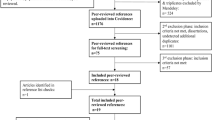Abstract
Seeking to identify conditions that support newly implemented evidence-based practices, this case study examined an implementation in which an existing agency was invited to move into the neighboring county to introduce its “housing first” practice with seriously mentally ill homeless adults. Using a constructivist methodology to elicit the narratives of key actors and observers about the implementation and its attendant controversy, this study found three issues at the core of actors' experiences: mode of presentation, use of an outside agency and the questioned uniqueness of the new practice. Barriers rather than facilitators dominated participants' interpretations of events despite significant researcher-observed facilitators.
Similar content being viewed by others
REFERENCES
Anthony, W.A., Cohen, M., & Farkas, M. (1990). Psychiatric rehabilitation. Boston: Center for Psychiatric Rehabilitation.
Brown, P. (1995). The role of the evaluator in comprehensive community initiatives. In J. Connell, A. Kubisch, L. Schorr, & C. Weiss (Eds.), New approaches to evaluating community initiatives: Concepts, methods and contexts. Queenstown, MD: The Aspen Institute.
Burns-Lynch, B. & Salzer, M.S. (2001). Adopting innovations-Lessons learned from a peer-based hospital diversion program. Community Mental Health Journal, 37, 511-521.
Constantino, V., & Nelson, G. (1995). Changing relationships between self-help groups and mental health professionals: Shifting ideology and power. Canadian Journal of Community Mental Health, 14, 55-70.
Cupaiuolo, A. (1990). Homelessness in Westchester County: A human tragedy, a fiscal disaster. Public Management, May, 21-23.
Friedman, S.J., & Terkelsen, K.G. (Eds.) (1988). Issues in community mental health: Housing. Canton, MA: Prodist.
Gergen, K. (2001). Psychological science in a postmodern context. American Psychologist, 56, 803-813.
Green, L.W., & Mercer, S. L. (2001). Can public health researchers and agencies reconcile the push from funding bodies and the pull from communities? American Journal of Public Health, 91, 1926-1929.
Greenley, J.R. (1995). Madison, Wisconsin, United States: Creation and implementation of the Program of Assertive Community Treatment (PACT). In R. Schulz & J.R. Greenley (Eds), Innovating in community mental health: International perspectives (pp. 83-96). Westport, CT: Praeger.
Guba, E.G.,& Lincoln, Y.S. (1989). Fourth generation evaluation. Newbury Park, CA: Sage Publications.
Hasenfeld, Y. (1983). Human service organization. Englewood Cliffs, NJ: Prentice Hall.
Hoge, M.A., & Howenstine, R.A. (1997). Organizational development strategies for integrating mental health services. Community Mental Health Journal, 33, 175-187.
Hopper, K., Jost, J., Hay, R., Welber, S., & Haugland, G. (1997). Homelessness, severe mental illness, and the institutional circuit. Psychiatric Services, 48, 659-665.
Jacobs, S., Davidson, L., Steiner, J.,& Hoge, M. (2002). The integration of treatment and rehabilitation in psychiatric practice and services: A case study of a community mental health center. Community Mental Health Journal, 38, 73-81.
McLean, A. (1994). Empowerment and the psychiatric consumer/ex-patient movement in the United States: Contradictions, crisis and change. Social Science & Medicine, 40, 1053-1071.
Nelson, G. (1994). The development of a mental health coalition: A case study. American Journal of Community Psychology, 22, 229-255.
Nelson, G., Lord, J., & Ochocka, J. (2001). Shifting the paradigm in community mental health: Towards empowerment and community. Toronto: University of Toronto Press.
Persons, J.B. (1995). Why practicing psychologists are slow to adopt empirically validated treatments. In S.C. Hayes, V.M. Follette, R.M. Dawes, & K.E. Grady (Eds.), Scientific standards of psychological practice: Issues and recommendations (pp. 141-157). Reno, NV: Context Press.
Rappaport, J. (2000). Community narratives: Tales of terror and joy. American Journal of Community Psychology, 28, 1-24.
Ridgway, P., & Zipple, A.M. (1990). The paradigm shift in residential services: From the linear continuum to supported housing approaches. Psychosocial Rehabilitation Journal, 13, 20-31.
Schulz, R. & Greenberg, G. (1995). Theory and framework for evaluating the implementation of change. In R. Schulz & J.R. Greenley (Eds), Innovating in community mental health: International perspectives (pp. 19-40). Westport, CT: Praeger.
Schulz, R. & Greenley, J.R. (Eds.) (1995). Innovating in community mental health: International perspectives. Westport, CT: Praeger.
Shinn, M., Tsemberis, S., Asmussen, S., Toohey, S., & Moran, L. (2002). Effects of housing first and continuum of care programs for homeless individuals with psychiatric diagnoses. Manuscript submitted for publication.
Stein, L. (1995). Persistent and severe mental illness: Its impact, status, and future challenges. In R. Schulz & J.R. Greenley (Eds.), Innovating in community mental health: International perspectives (pp. 3-17). Westport, CT: Praeger.
Torrey, W.C., Drake, R.E., Dixon, L., Burns, B.J., Flynn, L., Clark, R.E., & Klatzker, D. (2001). Implementing evidence-based practices for persons with severe mental illnesses. Psychiatric Services, 52, 45-50.
Tsemberis, S., & Eisenberg, R.F. (2000). Pathways to Housing: Supported housing for streetdwelling homeless individuals with psychiatric disabilities. Psychiatric Services, 51, 487-493.
Wade, W. A., Treat, T. A., & Stuart, G. L. (1998). Transporting an empirically supported treatment for panic disorder to a service clinic setting: A benchmarking strategy. Journal of Consulting and Clinical Psychology, 66, 231-239.
Author information
Authors and Affiliations
Corresponding author
Rights and permissions
About this article
Cite this article
Felton, B.J. Innovation and Implementation in Mental Health Services for Homeless Adults: A Case Study. Community Ment Health J 39, 309–322 (2003). https://doi.org/10.1023/A:1024020124397
Issue Date:
DOI: https://doi.org/10.1023/A:1024020124397




